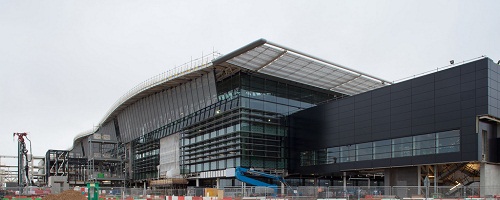
Heathrow Airport originally opened its first Terminal 2 building in 1955. After 54 years of service, it was closed in 2009 and demolished in 2010 in order to create a new and improved T2. Originally called the “Europa Building”, the infrastructure had been designed to deal with 1.2 million passengers per year, yet it was dealing with over 8 million by the time it was closed.
The new is the result of a development project that has invested £2,5 billion pounds to build a world-class infrastructure. The result? The new T2 incorporates a main building and a satellite terminal, totaling 28 aircraft stands to go along with a 1,300 space car park, a new energy centre, 60 fast bag drop stands, 56 traditional check-in desks, 17 security lanes…
But nowadays, a building like the new Terminal 2 is not only expected to be efficient, but also sustainable. The following are 10 of the many reasons why we have also fulfilled this challenge:
- 20% of T2’s energy needs will be from renewable sources.
- The new Terminal will have 40.5% less CO2 emissions than a modern building developed under 2006 regulations.
- There will be 1,000 square metres of photovoltaic panels on the building’s canopy.
- The new Terminal 2 will be home to a 12MW biomass boiler heater which will produce energy for the airport. The wood used to power the boiler is sustainably sourced, FSC approved timber.
- Extensive glazing will bring in more natural light, which will reduce the electricity needs of the new building. As well as glazed walls, north-facing skylights in the roof will provide glare-free daylight without heat gain (which would mean more air conditioning). To prevent solar heat gain, the glazed facade incorporates solar control glass and angled louvres, while an overhanging roof shades the south-facing windows.
- A sophisticated lighting control system will keep energy use down by switching lights off when parts of the building are not in use or when daylight is bright enough
- 95% of the demolished buildings were recycled (Old T2 and the Queen’s building)
- The layout of aircraft stands at Terminal 2 will mean planes can taxi more efficiently to the runways reducing ground level emissions and improving air quality. Mirroring the way buildings are arranged at Terminal 5; this is called a ‘toast rack’ layout.
- Aircraft stands will allow units to supply aircraft with electricity and preconditioned air so that they don’t have to run their auxiliary engines when stationary.
- The first energy phase will potentially save around 13,000 tonnes of CO2 a year, compared to the use of natural gas and grid electricity.





There are no comments yet